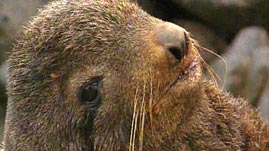Teachers' Domain - Digital Media for the Classroom and Professional Development
User: Preview

Source: First Alaskans Institute
In this video segment from First Alaskans Institute, learn about northern fur seals (laaqudan), their importance to the Alaska Native diet, and how the community of St. Paul Island participates in their conservation and protection. Explore some of the human-produced hazards that affect the seals and observe how students act as stewards by cleaning up plastic and nets from beaches. Discover how Islanders are integrating old and new ways of knowing, such as in their crafts and in careers in ecotourism and research.
Northern fur seals, named for their dense underfur, are marine mammals that live in the North Pacific Ocean and Bering Sea. They were once hunted extensively by Japan, Russia, and other countries for their luxurious pelts, which led to a major decline in their population. In 1911, the North Pacific Fur Seal Treaty placed restrictions on the commercial hunting of the seals, allowing their numbers to rebound. Today, northern fur seals may only be hunted by indigenous peoples for subsistence purposes, such as for food and clothing; Aleuts have depended on northern fur seals for thousands of years, taking only the nonbreeding males for subsistence use.
The majority of the world's northern fur seals breed in the Pribilof Islands, located in the central Bering Sea. Each summer, the seals gather onshore in rookeries—breeding colonies along the coast. The males arrive first to establish their territories, each of which will host dozens of females. Subsequently, the females arrive to give birth. Over the next four months, the females will alternately nurse the pups and go out to sea on foraging trips while the males maintain their territories and fast. In the fall, the seals migrate (some as far south as the coast of California) and spend the next several months at sea until the next breeding season.
In 1988, the northern fur seal stock of the Pribilof Islands was designated as depleted; it was less than 50 percent of the level observed three decades earlier. The number of northern fur seals has continued to decline, but research has yet to determine the cause or causes. Possible explanations for the decline include threats from industrial-scale commercial fisheries, predators, and environmental changes. For instance, commercial fisheries may be depleting the seals' food resources (they primarily eat fish and squid). Climate change may also influence the availability of their food sources. In addition, fur seals may become entangled in fishing gear or be unintentionally harvested by fisheries. They are also at risk of entanglement in other human-produced debris, such as twine and plastic packing bands. It is possible that predation, such as by killer whales, has increased; seal pups may also fall prey to foxes and sea lions. Other environmental factors, including pollution, also impact seal health.
 Loading Standards
Loading Standards Teachers' Domain is proud to be a Pathways portal to the National Science Digital Library.
Teachers' Domain is proud to be a Pathways portal to the National Science Digital Library.
